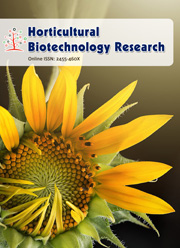Influence of medium and growth regulators on callogenesis of quinoa (Chenopodium quinoa Willd.) and effect of hydrous stress induced by P.E.G 6000 on the callus
DOI:
https://doi.org/10.25081/hbr.2017.v3.3378Abstract
The induction and growth of quinoa’s callus depend on several factors, including the culture medium and the nature of the growth hormone and its dose. In effect, the best callogenesis rates were obtained with the media MS and B5 with respect to the media WHITE and KNOP the callogenesis is too low or zero. The best combination used was 0.2 BA + 2.4 D give well-developed callus. To obtain water-stress resistant cell lines, the effect of water stress induced by polyethylene glycol (P.E.G 6000) on the growth, osmotic potential and metabolic parameter of Chenopodium quinoa callus was studied. Applied water stress showed a reduction in the growth of stressed callus compared to the control. The presence of PEG in the culture medium caused a decrease in the content of fresh matter as well as the dry matter content compared to the control. Water stress also significantly affected the water parameters of calluses. The chlorophyll a, b and carotenoids content decreased, but this decrease is not too pronounced.






 .
.